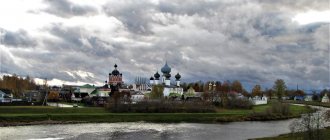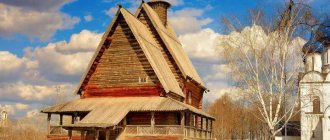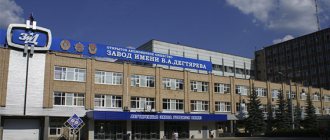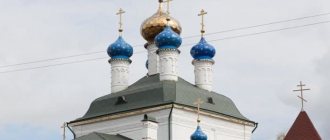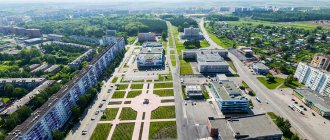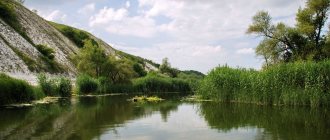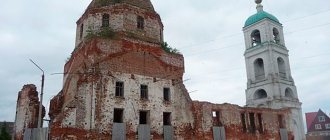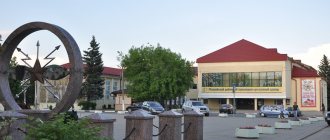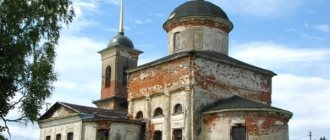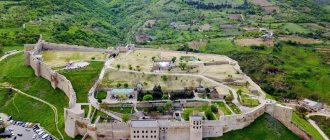Year founded: 1239
Vyazma - City of Military Glory
Vyazma
is a Russian city in the east of the Smolensk region, the administrative center of the Vyazemsky district, 175 km northeast of Smolensk. City with an area of 49 square meters. km located on the Vyazma River (tributary of the Dnieper).
The name of the city is associated with swamps, it is formed from the words “elm”, “viscous”. Vyazma was first mentioned in chronicles in 1239
, when the city was transferred to Prince Andrei Vladimirovich.
Since 1403, Vyazma was part of the Grand Duchy of Lithuania, and was subsequently captured by the Poles several times. In 1618, the city finally ceded to the Russian state, but enemy raids continued, and in the 1630s, by order of Tsar Mikhail Fedorovich, a fortress with earthen fortifications and stone loopholes was created - the Great Lower City.
Monument to the Pernovsky Regiment (Photo: wikipedia.org) During the Patriotic War of 1812, near Vyazma, Russian troops defeated the retreating Napoleonic army. In memory of this event, two monuments were erected in the city.
By the 18th century, Vyazma had become an industrial and commercial center, where blacksmithing and leather crafts flourished. A hundred years later, 8 gingerbread factories appeared here. In 1856, in the provincial town of Vyazma, there were 26 churches, 1,456 houses, and 213 shops.
During the Great Patriotic War, fierce battles took place near Vyazma. In the fall of 1941, during Operation Typhoon, many Red Army units were surrounded by the enemy. On October 7, 1941, Nazi troops occupied the city. During the Rzhev-Vyazemsk operation, the almost completely destroyed city was liberated. By decree of the President of the Russian Federation in 2009, Vyazma was awarded the honorary title “City of Military Glory”.
The architectural appearance of Vyazma is largely determined by buildings of the 17th and 18th centuries, some of which have been preserved, while others were restored after the war. In the central part, on a high hill, there is the 17th century Trinity Cathedral with a refectory and bell tower, and the Spasskaya Church in the Naryshkin Baroque style. In the town square you can see the Church of the Nativity of the Virgin. Here, nearby, there is a monument in honor of the battles near Vyazma in 1812.
Trinity Cathedral (Photo: wikipedia.org)
The Spasskaya Tower of 1631, the Arkadyevsky Monastery, the Vvedenskaya Church, and ancient residential buildings have been preserved from the fortifications. The St. John the Baptist Monastery with the Church of the Hodegetria of Smolensk (17th century) is especially popular among citizens and guests of the city.
Interestingly, the city near Moscow is famous for its girls in aviation. In Vyazma in 1972, the famous pilot-cosmonaut, twice Hero of the Soviet Union, Svetlana Savitskaya, underwent flight training and mastered the MiG-15 and MiG-17 jets here. And in 2012, Ekaterina Zaitseva made an independent flight in Vyazma on an L-39 aircraft. She became the first girl in modern Russia to fly on a jet plane.
Day of the city
Vyazma is traditionally celebrated on the Orthodox holiday of the Holy Trinity.
Church of the Smolensk Icon of the Mother of God, called “Hodegetria”
The church in these places appeared in the 17th century and is popular among believers throughout the region. The attraction is included in the UNESCO World Heritage List.
This is a unique example of Russian architecture, a creation created at the turn of change, when the tent style was becoming a thing of the past. Only three such churches have survived in the country: in Vyazma, Putinki and Uglich.
The temple is located on Dokuchaev Street, 48A.
Museum of History and Local Lore
As is usually the case here in Rus', local history museums are located in the buildings of former temples or churches. The shelter for this museum was the boundary of the 17th-century Virgin Mary Church, which now houses more than 16 thousand unique exhibits. There is also an art salon of local painters.
Church of the Nativity of the Virgin Mary
This is a brick structure erected from 1782 to 1785. The bell tower of the church is free-standing, and the temple itself was built in the Baroque style. The church is also known for the fact that in 1812 liberation battles from Napoleonic troops were fought near its walls.
The church is located at Sovetskaya Square, 3 and since 1970, after restoration work, it has housed a local history museum.
Top 5 places suitable for holidays with children
Vyazma, whose sights will captivate mainly adults, is also a place for interesting and comfortable pastime with children:
- In the city center, next to Efremov Square, there is a Central Park with attractions, playgrounds and cafes.
- Here, on Efremov Square, you can stroll by the general’s monument and see the Eternal Flame.
- At Sovetskaya Square 2a there is a theater for young spectators.
- For older children, it will also be interesting to visit the Museum of History and Local Lore at Sovetskaya Square, 3.
- The Bastion entertainment sports club is located at Zavodskaya Street, 29.
Holy Trinity Cathedral
This is the main cathedral of the city, built in 1676. Located on the left bank of the river, on the territory of the fortress. The first mention of the St. Nicholas Church (old name) is in the chronicles of 1015. In 1635 it was renamed Holy Trinity Cathedral. In 1812, the building was completely burned. Later, the temple was restored with funds allocated by the merchant Sabelnikov in 1847.
Today it is a two-altar cathedral, made in the classical style typical of Moscow churches at the turn of the 16th century. The decorative elements of the building are made in pseudo-Russian style.
The temple is located on Nagornaya street, 1.
Spasskaya Tower
This tower was built in the 17th century and was part of the city fortress, one of its six towers. The fortress was also heavily damaged by the French in 1812; only the three-tiered Spasskaya Tower survived. It is noteworthy that the thickness of the tower walls is six meters, and its height is 28 meters. After the war of 1812, a warehouse for the Arkadyevsky Monastery was located here.
Svetlana Savitskaya's plane
Between Repin Street and 25th October Street, on the territory of a small city square, a monument to Svetlana Savitskaya was erected. This is a real MiG-17 model aircraft. It was on this aircraft that Svetlana began her training.
The design of the monument is presented in such a way that it seems that an airplane is taking off. Savitskaya is an honorary citizen of the city and twice a hero of the Soviet Union.
Soviet square
The main city square, around which the main architectural monuments of the city are located, faces the Vyazma River, to which there is a wide descent. Initially, the square was called Torgovaya and used to host large and noisy fairs; now the main citywide events, parades, city day and others are held here.
Epiphany Church
This is a functioning temple in Vyazma, with a rich iconostasis. The building is snow-white, with blue domes, and is open to visitors by believers. It was built in the 18th century entirely with donations from local residents. The architecture of the building is elegant, it is made in the Baroque style.
A local history museum has been opened in one of the cathedral's premises. The church still operates a library, a Sunday school, and an Orthodox camp for children.
Thematic exhibitions and fairs with the participation of folk craftsmen are often held on the territory of the temple.
The temple is located on Paris Commune Street, 18.
Excursion routes
The most popular excursion route is a visit to the Khmelita Museum-Reserve and a sightseeing tour of the city of Vyazma. The sights that can be seen by choosing this route are, first of all, the Griboyedov estate, located 37 kilometers from the city, as well as the most beautiful churches of Vyazma - the Trinity Cathedral and the Cathedral of the Mother of God Hodegetria.
In addition, guests visit the local history museum, get acquainted with the history of the city, and can see the city’s most beautiful churches and monuments related to the events of the Great Patriotic War.
Monument to General Efremov
A monument to the general was erected on Efremov Square. He was the commander-in-chief of the 33rd Army. The general himself died in 1942 in battles in Vyazma. There is a tragic story associated with his death. When the regiment was surrounded and Efremov was wounded, in order not to be captured, he committed suicide. Efremov received the title of Hero of Russia posthumously in the 90s.
The monument was erected in 1946. This is a pedestal with 5 figures, one of which is a general, he gives commands to his soldiers to go into battle. The monument is made of gray granite.
Vyazma as a witness to history
31.03.2014
Vyazma is one of the historical monuments of the Smolensk region. A small town between Smolensk and Moscow on the Old Smolensk Road attracts tourists with masterpieces of ancient architecture and a cozy provincial atmosphere. Meanwhile, the fate of our state was repeatedly decided here - in 1812 and 1941.
Vyazma is one of the historical monuments of the Smolensk region. A small town between Smolensk and Moscow on the Old Smolensk Road attracts tourists with masterpieces of ancient architecture and a cozy provincial atmosphere. Meanwhile, the fate of our state was repeatedly decided here - in 1812 and 1941. Residents of the city showed themselves to be courageous defenders of the Fatherland, patriots of their native land, and guardians of Russian traditions.
Today, Vyazma is the center of the Vyazemsky district, a city with a population of 55 thousand people, located at the confluence of the two rivers Vyazma and Bebri, on the old Smolensk road.
Vyazma was first mentioned in written sources in 1239 - then the city was given to Andrei the Long Hand, the son of the Smolensk prince Vladimir Rurikovich. At the same time, the Vyazemsky appanage principality was already an integral part of the Smolensk Grand Duchy.
In 1403, Vyazma, among the appanage cities of the Smolensk land, became part of the Grand Duchy of Lithuania, Russia and Zhemoytka. But already in 1493, during the Russian-Lithuanian war of 1487-1494, it was captured by the Moscow principality.
During the time of Ivan the Terrible, Vyazma was assigned to the oprichnina (1565). Ivan the Terrible visited the city in 1563 and 1566 and attended services in the Cathedral Church.
During the Time of Troubles, peasant unrest occurred in the vicinity of Vyazma; after the invasion of Polish troops, the city repeatedly changed hands. In 1612, Vyazma sent its detachment to the militia of Prince Pozharsky. After the end of the war, the city went to the Russian kingdom, and an exchange of prisoners took place between the parties. However, Polish raids on Vyazma continued, and in the 1630s, Tsar Mikhail Fedorovich ordered new fortifications to be built in the city. By 1632, a new fortress was created - the Great Lower Town. From October 21, 1654 to February 10, 1655, Vyazma temporarily became the seat of the Russian government: returning from Smolensk with an army, Tsar Alexei Mikhailovich was forced to stop in Vyazma due to an epidemic that broke out in Moscow. Patriarch Nikon and the entire royal family arrived here. A wooden palace was built in the city.
(Battles near Vyazma in 1812)
Vyazmichi wrote one of the heroic pages in the history of the Patriotic War of 1812: they collected one and a half million rubles for the defense of Russia and deployed 12,447 militias. Residents fought in the partisan detachments of D. Davydov, A. Figner, A. Seslavinsky. Fierce battles took place near the city walls twice – in August and October 1812. Over a thousand residents of the district took part in the Battle of Borodino. On October 22, 1812, Vyazma became the site of a large battle between the retreating Napoleonic army and Russian troops. In honor of this victory, two monuments were erected in the city.
On the centenary of the war, a monument to the heroes of 1812 was unveiled in Vyazma. It represents a rock, on top of which a double-headed eagle, symbolizing Russia, spread its wings. He flutters the standard of the defeated French army. Another monument dedicated to the events of 1812 is located on Sovetskaya Square, not far from the Church of the Virgin Mary. This is a monument to the soldiers of the Pernovsky regiment, erected on the spot where they fought with the French Guard.
(Monument to the heroes of 1812)
By the middle of the 19th century, Vyazma became a major trading center not only in the Smolensk region, but also in Russia. Located on the Old Smolensk Road, which connected Moscow with the capitals of the Western powers, Vyazma played the role of a trade intermediary: goods passed through it to Belarus, Poland and other countries, and through Gzhatsk and Rzhev to St. Petersburg.
Industry developed in the city, 57 enterprises operated. In 1850, 8 gingerbread factories operated in Vyazma, of which the most famous were the factories owned by the merchants Echeistovs, Kustarevs and Sabelnikovs. The best gingerbreads, which earned world fame and made Vyazma famous, were considered to be the gingerbreads baked at the Sabelnikovs’ factory.
(Monument to the Pernovsky Regiment)
There were wax factories, tile and brick factories, and even had its own bell factory, which satisfied the province’s needs for bells. The local merchants received large incomes from the flax trade. In 1870, operation of the newly built Moscow-Vyazma-Smolensk railway began, and in 1874, the Syzrano-Vyazemskaya and Rzhevsko-Vyazemskaya railways. By the end of the 19th century, 16 thousand people lived in Vyazma, and two- and three-story houses began to be built in the city. There were about 400 of them.
After the revolution, the city's industry received further development. During the pre-war five-year plans, bread, meat and food processing plants and a brick factory were built in Vyazma. There were 3 flax mills and 10 oil factories, a furniture factory and a vinegar factory were being built.
04.20.-.jpeg
(View of Vyazma at the beginning of the 20th century. Photo by S.M. Prokudin-Gorsky)
Vyazma became notorious during the Great Patriotic War due to the tragedy of the so-called “Vyazma Cauldron”. In the fall of 1941, during Operation Typhoon near Vyazma, soldiers of the Red Army were surrounded by the enemy: 37 divisions, 9 tank brigades, 31 artillery regiments of the RGK and field departments of four armies with a total number of up to 600,000 people, including 10 divisions of volunteer militias from Moscow aged 16 to 60 years. Of the 15,000 militiamen from the capital's 7th Bauman People's Militia Division, about 14,000 died near Vyazma. In total, about 400,000 Soviet citizens died in the battles near Vyazma in October 1941. During the breakthrough, 85,000 escaped the encirclement, but about 688,000 Soviet soldiers and officers were captured.
The territory of the city itself and the Vyazemsky district became the scene of brutal and bloody battles. Later, Marshal Zhukov noted how great the role of Vyazma was, which made it possible to gain time to organize defense on the Mozhaisk line. The troops pinned down 28 German divisions for two weeks, but the price they paid for this delay was hundreds of thousands of lives.
German aviation carried out the first air raid on Vyazma on June 31, 1941 - the war came to this city very quickly. Hundreds of bombs were dropped on it. More than 500 people died that day. But already in September 1941, a partisan detachment of K.S. Zaslonov, the former head of the Roslavl locomotive depot, was created in the city, who organized sabotage on the railway to blow up German trains. In memory of the courage of Vyazma railway workers, a monument was erected near the station - the steam locomotive ESH-4290.
(Monument to the heroism of Vyazma railway workers)
In October 1941, the Nazis managed to encircle 12 divisions of the Western and 4 divisions of the Reserve Front. An attempt by four armies under the command of Lieutenant General M.F. Lukin to break through to the main forces was unsuccessful. On October 7, 1941, Vyazma was occupied by the German army. By order of the command of the 33rd army of General Efremov, which liberated Naro-Fominsk, Borovsk and Vereya, went to Vyazma. On the night of February 2-3, 1942, the enemy managed to cut off the advanced units from the mainland. Efremov's army was surrounded. For two and a half months, without ammunition, fuel, or food, the 4 surrounded divisions fought the hardest battles. Until April 1942, General Efremov never received permission from the command to leave the encirclement. To the general’s credit, it must be said that he did not accept Stalin’s offer to leave his doomed army on a sent plane. On the night of April 13-14, his exhausted army made a breakthrough, but Efremov’s men were unable to break out of the encirclement. Seriously wounded and immobilized, General Efremov decided to commit suicide. At the site of the last battle of the general and his army, near the village of Slobodka, a monument in the shape of a star was erected. Later, the general’s ashes were reburied at the Catherine Cemetery in Vyazma.
During the occupation, which lasted 17 months, about 30 thousand inhabitants died in the city. The Vyazmichi people who survived this terrible time do not like to remember those events. But their memory stores terrible pictures. In Vyazma there were at least two German camps for prisoners of war and civilians of the USSR - Dulag No. 184 and Dulag No. 230. The prisoners were often not fed or given water. In the winter of 1941-1942, the death rate in the camp was up to 300 people per day. In another transit prison in Vyazma (Dulag No. 230) in October 1941, during an inspection carried out by an Abwehr officer, 200 Jews and 50-60 political instructors were discovered, a few days later another 40 Jews and 6-8 political instructors were identified there. All of them were shot. In December, 117 Jews were identified and executed in a prisoner-of-war camp in Vyazma.
The Nazis burned 6 hospitals, 12 schools, a power plant, a church, a women's gymnasium, Frolovskaya and other churches, a bakery, plants and factories, two bridges over the Vyazma River, cut down two city parks, so there are no centuries-old trees in the city. Soviet troops entered Vyazma on the night of March 11-12, 1943. The city was destroyed and burned to the ground. Of the 5 and a half thousand buildings, 51 houses remained intact. On March 15, Konstantin Simonov will write: “Vyazma is broken and burned so much that I can’t understand anything: from one end the extreme ruins at the other end of the city are clearly visible.”
(Monument to General M.G. Efremov)
Vyazma was included in the list of 15 ancient Russian cities requiring immediate restoration. Already in 1946, a monument to General Efremov was erected on the central square. Unfortunately, in order to erect a monument, the Soviet authorities decided to blow up one of the most beautiful city churches - Dukhovskaya, built at the beginning of the 18th century.
The city was awarded the proud name of “City of Military Glory”. It quickly revived after the war and became a major commercial and industrial center. The city is home to engineering, tanning, and synthetic products factories (VZSP OJSC), as well as the Vyazmakhlebproduct enterprise, a flax mill, the L'Avissal cosmetics shop, a plant for the production of plastic products (Plastic Republic LLC), and mining industry. processing plant, flax plant, plant for processing the natural mineral brucite (Vyazma-Brusit LLC), as well as the Vyazma branch of OJSC BET, the Vyazma plant for reinforced concrete sleepers, the largest in terms of capacity in Russia. The volume of shipped goods of own production by type of manufacturing (2010) is 8.77 billion rubles.
Vyazma is a major transport hub in the Smolensk region, both railway and road. The city has a locomotive depot, two convoys, and numerous enterprises for servicing railway and road transport. There are several dozen bus routes.
(Temple of Hodegetria)
But tourists are attracted by the historical values of Vyazma. One of the main decorations of the city is the Temple of Hodegetria, built in 1635-1638. It stands on the site of the wooden monastery of John the Baptist, founded in 1536. This is a magnificent monument of hipped-roof architecture. The abundance of kokoshniks, arches, and pediments makes the building very elegant and memorable. There are only two such temples left in Russia - with three stone tents placed in one row - the “Wonderful” Church in Uglich and the Church of Hodegetria in Vyazma.
(Trinity Cathedral)
Not long ago, restoration work was completed at the Trinity Cathedral, located on Cathedral Hill in the city center. It was built in 1674-1676 by decree of Tsar Alexei Mikhailovich in honor of the complete liberation of the Smolensk principality from Polish invaders. In the middle of the 19th century, a new refectory and bell tower were added to it. The interior decoration of the cathedral is very interesting - the main motifs of the carvings decorating it are vines and stylized flowers.
The Church of the Virgin Mary was built in 1728 on the square called Torgovaya (it was where the city's shopping arcades were located). Nowadays, the church houses a local history museum, from the collection of which you can glean quite detailed information about the history of the city. Also in the city there is a unique church of Alexander Nevsky, consecrated by Metropolitan Kirill of Smolensk and Kaliningrad, now the Patriarch of All Russia.
(Theotokos Church)
In the ancient village of Khmelita, an 18th-century estate (the estate of the Griboyedov family) has been restored. The world's only museum of the writer A.S. is located in the beautiful palace ensemble. Griboedova. On the ancient Belsky tract there is a rural cemetery where the ashes of P.S.’s parents rest. Nakhimov, great admiral. The crypt is located near the ruins of the Church of the Savior-Vologzhan, where P.S. was baptized. Nakhimov.
Among the names of people associated with Vyazma, who made a great contribution to the history of the Fatherland, writers A.S. Griboyedov and M.A. Bulgakov, naval commander P.S. Nakhimov, composer A.S. Dargomyzhsky, artists N.S. Plotnikov, A.D. Papanov, L.I. Kasatkina, whose childhood and youth were connected with the Vyazma land.
The Vyazma land gave the world several saints. Among them are Blessed Juliana, Princess Vyazemskaya and Novotorzhskaya, and Venerable Arkady of Vyazemskaya and Novotorzhskaya.
Juliania Vyazemskaya, the daughter of boyar Maxim Danilov, became famous for her high marital chastity. Her husband, Prince Simeon Mstislavich of Vyazemsk, together with Prince of Smolensk Yuri Svyatoslavich, was forced to flee from his native lands, which were captured by the Lithuanian prince Vitovt. Then the Moscow prince Vasily Dimitrievich gave the Tver city of Torzhok to the exiled princes. Prince Yuri Svyatoslavich was captivated by Juliania’s beauty and tried in every possible way to persuade her to commit adultery, but Juliania strictly maintained marital fidelity. One day during a feast, Prince Yuri killed Juliania’s husband, hoping to take her by force. Saint Juliana resisted the rapist. The enraged Prince Yuri ordered her legs and arms to be cut off, and her body thrown into the Tvertsa River. The martyrdom of Saint Juliana took place in the winter of 1406. Out of remorse, Prince Yuri fled to the Tatars, but even there he did not find peace. Then he retired to the Ryazan Hermitage (where he died in 1408). In the spring of 1406, the body of the blessed princess was seen floating against the current. A certain paralytic heard a Voice from above, commanding that the body of Saint Juliana be buried at the southern gate of the cathedral in Torzhok. The coffin with the body was subsequently placed in the Transfiguration Cathedral, where many received healing from it.
The Monk Arkady of Vyazemsky and Novotorzhsky came from the city of Vyazma from simple pious parents; he chose the foolishness of Christ for his feat. He was led by an experienced mentor, the Monk Ephraim of Novotorzh the Wonderworker. Together they participated in the founding of a temple and monastery in honor of the holy noble-believing passion-bearer princes Boris and Gleb, where they repeated the feat of obedience, remaining in prayer, fasting and silence. The relics of St. Arkady, glorified by miraculous healings, were found on July 11, 1677 in the stone crypt of the Boris and Gleb Cathedral in the city of Torzhok.
Vyazma is small in size, but huge in historical events, a proud, ancient city that combines the architecture of ancient buildings, beautiful churches and new beautiful houses.
Elena Shikova
Stele "Vyazma - the city of military glory"
The stele is located on Soviet Square. Nearby there is a monument perpetuating the glory of the Pernovsky Regiment and the “Mother’s Heart” monument.
In 2009, the city received the title “City of Military Glory” and already in 2011 the grand opening of the stele took place.
This is a high column (6 meters), topped with the coat of arms with the heraldic shield of the Russian Federation. The coat of arms depicts a double-headed eagle with several small gold-colored crowns and one large one, connected by a ribbon. The eagle holds a scepter with its right paw, and an orb with its left.
On both sides of the stele there are cubic granite pedestals, on which the main events that took place in Vyazma are depicted: graphic scenes of the Patriotic War and the Second World War.
Spaso-Preobrazhenskaya
The church was built in the first half of the 18th century on the site of a men's monastery destroyed by Lithuanian troops. The church was built at the expense of the local nobility and merchants. After the revolution, the new authorities transferred the church building to public organizations, which remained there until the end of the last century.
Church of Peter and Paul
On 3rd International Street, 1 there is a beautiful Church of Peter and Paul. It was built of red brick in the 19th century. Almost during the same period, a hospital for the poor was built nearby.
The temple has a rather tragic history: in 1929 it was turned over to a club, and later it was generally used as warehouse space. During World War II, Soviet soldiers were shot near the church. In memory of these events, a plaque was installed on the wall of the temple with the inscription: “Eternal memory.”
During the 70-80s of the last century, the temple was restored, but was transferred to the diocese only in 1992. However, since that time, the temple has not become operational and is gradually being destroyed.
Parks and gardens of Vyazma
The city Central Park of Vyazma begins at Efremov Square. There are attractions, cafes, and playgrounds here. It has a length and not always a happy story. During the war, executions of local residents by German soldiers took place here. Then, in the post-war years, the park was improved: there were carousels, a shooting gallery, billiards, and an orchestra played.
In the 90s, the place was again abandoned and unkempt. Now the park again welcomes city guests and Vyazmich residents. Nakhimovsky Park is located between Lenin, Baumanskaya and Pokrovsky streets. The park has benches for relaxation and a fountain.
Monument to Russian bast shoes
There is an interesting monument dedicated to Russian bast shoes on Soviet Square. It is made of red granite and is dedicated to all the people who, in the old days, trampled their bast shoes while walking along the Smolensk road.
The monument has a rather deep meaning; it symbolizes the fortitude of the Russian people, who, if they want something, will definitely achieve it.
Self-guided walking route
- You should start exploring Vyazma from Efremov Square; here is the monument to Efremov and the Eternal Flame.
- Next, you should go up to Lenin Street and see the Monument to the Valiant Ancestors.
- Here, at Lenin, 13, stands the famous Spasskaya Tower.
- Next you need to go to Nagorny Lane, 1 and linger in the beautiful Holy Trinity Cathedral.
- The route continues to Sovetskaya Square, where there is a modern monument to Lapt.
- Next to it, at Sovetskaya Square, 3, is the Museum of History and Local Lore.
- The last attraction of the route is located at some distance, namely 1.5 kilometers. A 20-30 minute walk will take you to Dokuchaev Street. Here, at addresses 45a and 48a, are the St. John the Baptist Monastery and the beautiful unique Church of Hodegetria.
Yesenin Literary Museum
On Efremov Square, 3, there is the only museum in the Smolensk region dedicated to the work of Yesenin. In terms of the value of the collected exhibits, it is not inferior even to the museum in Konstantinovo. A cozy and truly homely atmosphere has been created inside.
It all started back in 1955, when Propalov first heard Yesenin’s poems. He was so delighted with them that he began to collect bit by bit information, photographs, documents about the poet. Over time, the usual hobby allowed me to collect quite a decent collection. In 1986, Propalov decided to open a museum. However, officials for a long time did not want to assign museum status to the exhibition; naturally, there was no talk of any subsidies for maintenance.
To this day, the museum is housed in a communal apartment. The museum has eight thematic sections telling about different stages of Yesenin’s life.
Vyazma on the map of Russia: geography, nature and climate
Vyazma on the map of Russia is located on the Smolensk-Moscow Upland . Vyazma is located 175 km from Smolensk and 210 km from Moscow. The city stands on the Vyazma River , which is a tributary of the Dnieper.
Sand, gravel, peat and clay are mined in the area. The city stands at the place where the Vyazma River changes flow from south to northwest. In addition to the Vyazma River, within the city there is a large lake Bozino and numerous creeks.
Monument to Anatoly Papanov
In 1922, Anatoly Papanov was born in the city of Vyazma, who later became a famous Soviet actor. The monument is located on 25 October Street, 13, on the site where the actor’s father’s house once was.
The monument was erected in 2012, on Papanov’s 90th birthday. The wife and daughter, actors of the Moscow Academic Satire Theater, came to the grand opening. In honor of the anniversary, a decade of memory was held in the city. Over the course of 10 days, charity events, cultural and educational events took place, and classes dedicated to Papanov were held in schools.
The monument represents Papanov sitting in a shirt with an open collar. The actor sits on a bench and gesticulates, perhaps proving something or reading poetry.
Historical monuments of Vyazma
Vyazma, whose sights preserve the memory of the events of the Great Patriotic War, remembers and honors its heroes. In the center of the city there is an Eternal Flame on Efremov Square and a monument to General Efremov. Also in 1989, a Stele in memory of those killed in the Great Patriotic War was installed on Yamskaya Street.
Another war, the Patriotic War of 1812, is dedicated to the Monument to the Valiant Ancestors. It is located near the Pobeda cinema, which is located at Lenin Street, 13. This is a figure of a double-headed eagle tearing the French flag.
It was first erected in 1813, then suffered greatly during Soviet times. Restored and reopened in 1962 in honor of the 150th anniversary of the Battle of Borodino. More recent attractions include the monument to the scientist Konstantin Eduardovich Tsiolkovsky. Located in a park on Sverdlova Street, built in the 60s of the 20th century.
Church of the Vladimir Icon of the Mother of God
This church appeared in the city between 1770 and 1776. This is a four-tiered structure with five chapters. The largest repair work was carried out in 1851 and 1891. Later, repairs were carried out several times, in 1978 and 1982, but due to lack of funds, the work was never completed. The temple came into the possession of the diocese, but services are never held there.
John the Baptist Monastery
This monastery is considered one of the largest in the Smolensk region, organized with the highest permission of Ivan the Terrible himself in the 16th century. The wars that did not pass by caused great damage to the buildings of the complex, which had to be restored for a long time. The last restoration ended in 1976. After which male monks settled in the monastery, and five years later it became a purely female monastery.
Monument to St. Gerasim Boldinsky
As local legend says, Gerasim Boldinsky is the real savior of the city and the second guardian angel. According to legend, in the alder grove of Vyazma there was a camp of robbers. They robbed absolutely everyone, the local population, ambassadors, merchants who moved along the Old Smolensk Road. Gerasim decided to cope with this problem and built a monastery not far from Dorogobuzhem. In a short period of time, he managed to convert most of the robbers and the outrages stopped.
The monument is made in a classical style. This is the figure of a monk, in whose hands is an icon of the Mother of God. The grand opening of the monument took place in 2012 on the territory of the St. John the Baptist Monastery, which is located on Dokuchaev Street, 48A.
Under Gerasim, these were wooden buildings, but great people of their time visited this monastery: Ivan IV the Terrible, Boris Godunov, Patriarch Nikon.
In the 18th century, a theological school was opened in the monastery, but it existed only until 1918.
During the Patriotic War of 1812, the buildings were badly damaged and the French plundered the shrine. During the Second World War, the monastery had an even harder time; most of the buildings disappeared forever.
The real reconstruction was carried out in 1976, and in 1990 the walls of the monastery were opened again. However, the men's monastery was converted into a women's monastery in 1995.
Architectural objects and monuments of Vyazma
In the city center, not far from Soviet Square, on the streets of Kronstadt, Hegel, Paris Commune, Karl Liebknecht, Herzen, you can see monuments of urban architecture of the 18th-19th centuries. In the suburbs of Vyazma, namely 37 kilometers from the city, there is a museum-reserve, the former estate of the Griboedov family and now the Khmelit Museum. The poet Alexander Griboedov also visited here.
The estate was built and flourished in the 18th century. In the second half of the 19th century it was in a deplorable state. The new owner, Count Pyotr Alexandrovich Heyden, restored it. During Soviet times, the house suffered greatly from destruction, looting, and fire. Restoration began in the 60s. The museum opened in 1988.
The main exhibition includes objects of art and everyday life from the late 18th – first third of the 19th centuries. Temporary thematic exhibitions are also held. In 2002, a museum of Admiral Pavel Stepanovich Nakhimov, a native of the Smolensk region, appeared on the territory of the estate. It is located in the building of the former Griboedov greenhouse.
The admiral's workplace has been recreated here, photographs and archival documents have been collected. On the second floor of the museum there is an exhibition of paintings depicting battles in which Pavel Stepanovich participated, as well as models of warships. In the immediate vicinity of the Khmelita estate there are several more historical architectural monuments.
These are the Transfiguration Church of the late 18th century in the village of Grigorievskoye, the Church of the Ascension of 1793 in the village of Torbeevo, the garden and park complex of the 17th-19th centuries in the village of Lipitsy, the Akhtyrskaya Church of 1819 with preserved paintings in the dome and the chapel in the village of Pigulino, the Trinity Church of 1820 in the village of Fedyaevo, the Sheremetev estate of the mid-19th century in the village of Shirokoe.
Within a radius of 20 km from Khmelita, you can visit the Baryshnikov estate of the 18th - 19th centuries with preserved religious, residential, utility buildings, and partly a park.
It is located in the villages of Nikolo-Pogoreloe and Aleksino. The estate of Count Panin in the village of Dugino is a well-preserved park, cascading ponds, as well as partially extant outbuildings and two wings of the palace.
Church where two saints were baptized
What to visit : Church in honor of the Transfiguration of the Lord with the chapels of the Intercession of the Blessed Virgin Mary and the icon of the Mother of God “Burning Bush”.
Where: Strakhovoy Lane, 4.
What's interesting : The small Transfiguration Church, in which two saints of the Russian Orthodox Church were baptized: St. Macarius (Glukharev; 1792-1847) and Martyr John (Popov; 1867-1938), stands on a hill, east of the historical center of Vyazma. The church was erected in 1736 at the expense of the merchant Ivan Grigorievich Vyaznev.
On the western wall of the Transfiguration Church, fragments of paintings from the mid-19th century have been preserved, depicting Saints Equal-to-the-Apostles Constantine and Helen, and the Slavic enlighteners Cyril and Methodius. Like them, Saints Macarius (Glukharev) and John (Popov) devoted their entire lives to missionary activity.
Giant umbrella over a bus stop
What to visit : The most original sculpture of the city is located. The bus stop, made in the form of a brick semicircle with a round window, is covered by a huge umbrella.
Where: Sovetskaya Square.
Why it’s interesting: The monument appeared on March 8, 2014, in honor of Women’s Day, as a gift from the city administration.

